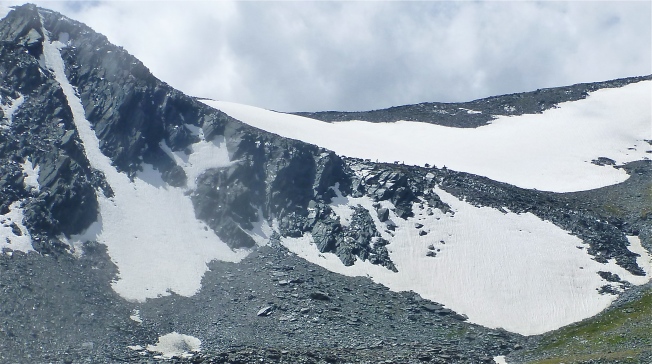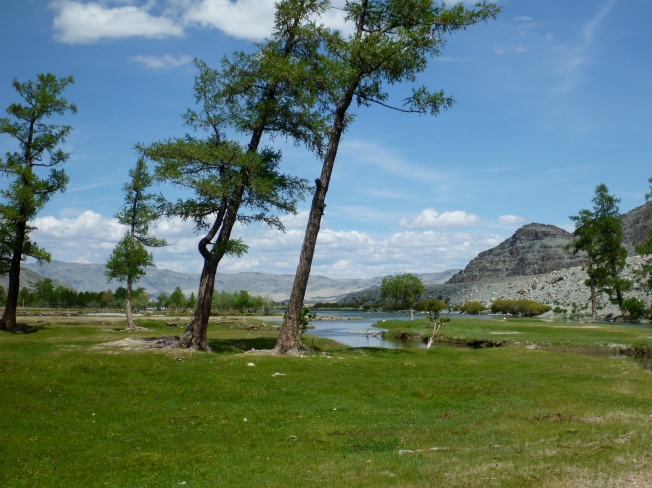Today is our final chance to ride, and we will be back in Ulgii by nightfall. For once it’s not raining, but the peaks are still playing hide and seek with the clouds. This glacier-carved terrain reminds me strongly of the Canadian Rockies, with its rocky summits, barren moraines U-shaped valleys.
I walk over to have a last chat with Pun’kin, passing Patrick, who is stroking the head of a saddled horse that is asleep on the ground.
Pun’kin is hobbled, head low, patient and resigned.
I scratch her forehead under the thick hair and rub her ears. She accepts the attention but doesn’t really respond. I know that she is reaching the age where she will become food for her owners. Horses here are used for only 15 years; their lives may be short, but they are treated well and their end is undoubtedly quicker and more merciful than North American animals experience in slaughterhouses.
We watch the camels being loaded with an ungodly amount of gear – hundreds of lbs surely. What strange creatures, constantly chewing their cud. They are almost machine-like in the way they carry their loads over all types of terrain.
The group photos require a lot of shuffling and jostling of horses as we try to get all the camels, riders and staff into a formation tight enough to fit a photo frame.
Then we are off, up and down ridges, mostly easy terrain.
I press Pun’kin into long, fast trots, but don’t let her gallop. She is completely responsive, as always, until I foolishly mess with my rain parka, spooking her into a tight spin that dumps me on the ground. No harm done from my rodeo stunt – just a bruised rib in payment for my stupidity.
A little less than 3 hours sees us to the rangers’ gers at the park entrance. We lunch inside one ger, then gather outside with all the staff to say goodbye and hand out tips. Hugs all around. We are sorry to see the camp crew and wranglers go as they have looked after us so well. The wranglers will take only 2 ½ days to return home with the horses. I don’t know what happens to the camels. Dosjan and Alex stay with us.
I say a reluctant goodbye to Pun’kin.
The vehicles have arrived from Ulgii, and we now face 5 to 6 hours of driving. On this route we do not have the Khot River, with its verdant riverine vegetation, to guide us. Instead we traverse a seemingly endless succession of brown valleys between brown hills that all look alike and which stretch in all directions. There is almost no sign of human life.
At one point the Russian van gets stuck in the mud, the rear wheels buried to the axle.
Our group is eager to offer help and suggestions. Eddie, meanwhile, co-opts the toilet stool and sits quietly. “Let them figure it out,” he advises. And indeed, after unloading the van and scooping out mud with bare hands, the entire crew push the van out with brute force.
The vehicle I’m riding in becomes separated from the others and our driver doesn’t know the way very well. Radio contact is lost, and so are we. Which valley? Which track? We finally see a ger quite a distance from our track. Our driver runs over and gets directions which may of may not be correct, but we follow them, becoming rather alarmed as we head north. Russia lies to the north; we want to go east. At last, however, we see the other Land Cruisers atop a hill, where they have been waiting while we made our little detour.
Ulgii at last, Dosjan’s home. We’re tired, but everyone wants to see a hunting eagle that Amy has mentioned. Eagles are used in fall and winter to hunt foxes and rabbits. Training is long and complicated, and the skills are passed down from father to son. The eagle we see is about 5 years old, hooded and perched low on a stout piece of wood. The owner’s son handles the bird under his watchful eye as we each get to don a thick leather glove and take the creature on our arm. Another first for all of us. I will cherish the photo.
Eddie, meanwhile, has taken off to pick up vodka for some of us. I ordered a beautifully decorated bottle of the local stuff for a neighbour, in thanks for looking after my mail while I’m gone. Dosjan has a different errand: Noa inadvertently deleted all the photos on the family camera. Dosjan has a degree in IT and teaches computing skills in the Ulgii high school. He later returns with the photos restored to the memory card.
We roll into the ger camp, tired, hungry and more than ready for hot showers and flush toilets. Later we gather in the dining ger, drink beer, wine or vodka, trying in vain to summon a party mood. The food arrives, we eat and soon collapse in our gers.
Some trips end on a high note; this one ends with an exhausted whimper. But we are forever changed. The memories of experiencing Mongolia in the centuries-old manner, on horseback, will endure. I know that I will return to do this trek again. And I can state that of all the countries I have visited outside of Canada, Mongolia and its people rank at the very top.
































































































